





Speed Management and Traffic Calming
Road related speed management involves ensuring that drivers and riders adopt safe speeds through engineering and speed limits.
Regulating traffic speed to levels commensurate with the road environment is crucial to the delivery of forgiving roads. To build a safe road system and to reduce deaths and serious injuries, the human body’s tolerance to impact forces should be used as a guiding tool. Impact speeds for different vehicle crash types after which the risk of death escalates are:
- 70 km/h head-on impact
- 50 km/h side impact
- 30 km/h side impact with objects
- 30 km/h impact with pedestrians, bicyclists and motorcyclists.
This framework serves as general guidance only and may need to be more stringent where warranted by local road conditions, vehicle types and intensity of conflicts among users. Where higher speeds are required then enhanced road design is necessary to ensure that safety of all users.
Speed limits
Regulation of speed is attained within a framework of speed limit and speed limit for heavy vehicles and buses.
However, speed limit setting is not an effective speed management measure if used in isolation. It must be complemented by:
- Design of the road infrastructure which aligns with the desired travel speed, so that the road is self-explaining and that a driver or rider can more intuitively regulate their speed based on the look and feel of the road.
- Traffic calming measures such as raised tables or chicanes may be deployed to ensure compliance.
- Effective speed enforcement.
Some countries also impose lower speed limit for certain adverse weather conditions. Besides, it is important that operators of public transport and logistics set out clear guidance for drivers for specific road conditions.
Traffic calming
Traffic calming are measures which lower motor vehicle speeds (and in some cases, traffic volumes), which aims to improve traffic safety, promote the accessibility and uptake of sustainable modes of transport, improve livability and protects the environment. Speed management is a form of traffic calming.
Traffic calming measures are most effective when implemented as part of an area-wide approach, that is, measures are applied across a network of streets rather than just a few corridors or sections of the roadway.
The most effective and safe traffic calming are part of the inherent design of a street or road that employs a range of complementary measures (as opposed to a single device type added after design and construction). Measures must also be spaced so as to maintain a target speed, rather than result in abrupt acceleration and deceleration. Importantly, drivers should not have to be taught about traffic calming devices for them to be effective. They should be self explaining and self-enforcing.
Selecting an appropriate set of traffic calming measures depends on the speed and function of the road. The table below provides an example list of traffic calming measures, and how appropriate they are for achieving different target speeds.
Vertical deflection
Vertical deflection is very effective for reducing fatal and serious injury crashes. It is recommended on use for streets where desired speed is less than 50km/h or as part of a side entry treatment.
Speed humps
Speed humps are either a narrow or wide raised section which spans the traffic lane. The geometry of the speed hump determines the speed at which traffic can travel over it, so the type and geometry of the speed hump should correspond with the desired outcome speed.
Speed humps should be used at midblock locations unless being incorporated as a raised pedestrian crossing. Speed humps should also be spaced at intervals to maintain desired speed. Gaps of 100m or more significantly increase average speeds.
Speed humps should not be used for high-speed roads, in isolation, or on roads where there is a steep downhill grade.
Speed cushions
Speed cushions, which are narrow humps in the centre of the lane, are designed to reduce the speed of cars, but allow larger vehicles, such as buses and emergency vehicles, to pass unimpeded. Similar to speed humps, they can be designed for different speed outcomes.
Speed cushions are usually more cost-effective than speed humps, but are less effective in reducing the speed of motorcycles.
Speed tables
A speed table is where the carriageway is raised to be level with the footway and removes the implicit priority of vehicles on street. Speed tables are recommended for low speed, high pedestrian flow areas (such as outside schools) or as a full raised speed table at intersections.
Speed tables can be used as a side road entry treatment (where small side streets intersect with main arterial roads) to slow traffic entering exiting the main road and prioritise pedestrian and bicyclist movements.
Horizontal deflection
Horizontal deflection is moderately effective for reducing fatal and serious injury crashes. It is recommended on use for streets where desired speed is less than 70km/h and can be incorporated into intersection design.
Access for larger vehicles such as buses and fire trucks should be managed through the design of overrun areas. An overrun areas visually narrows the roadway (through use of surface paint or other materials) while maintaining the effective width for larger vehicles.
Chicanes
Chicanes are artificial turns designed to reduce traffic speeds recommended for low volume, low speed roads. They can be used on a range of streets, from residential and local streets through to arterial roads, and are often integrated with on-street parking design.
Choke points
Choke points effectively reduce a two-way street to a single lane where drivers yield to oncoming vehicles (or a wide street into a narrower two-way where no yield is necessary). It is often incorporated as part of a pedestrian crossing design. Choke points are only appropriate for low volume local streets and care should be taken to ensure that the design considers cyclists needs. The traffic calming effect is more pronounced for one lane chokers compared to two lanes.
False roundabouts
A false roundabout is a central island with no side road connections (i.e. with only two arms). This can be used, where space is available, to give good deflection of motor vehicles and could be used as part of a gateway feature, or to break up long straight sections within a traffic calming scheme.
Horizontal deflection at intersections
Reducing curve radii
Tightening kerb radii forces turning vehicles to reduce speed at intersections, reduces pedestrian crossing distance and exposure, and improving visibility of and for pedestrians. There are three main types:
- Corner alignments, which extends the sidewalk corner to the tightest radius possible
- Kerb extensions (or ‘bulb-outs’) which are generally used to narrow the carriageway at the intersection to minimise pedestrian crossing distance. This is often incorporated into streets with on-street parking.
- Slip lane removal, which extends the sidewalk to include the space occupied by the lane and the traffic island.
Intersection realignment
Intersection realignment is where an intersection with perpendicular angles is reconfigured to skew approaches or travel paths through the intersection. It is best used for T-intersections and appropriate for both collector or local streets, with or without on-street parking and bicycle facilities.
Roundabouts
Roundabouts are known to reduce the frequency and severity of FSI outcomes, particularly for vehicle occupants. However, how effective a roundabout is as a traffic calming measure relies on its dimensions and design. Roundabouts can create barriers and pose safety risks for both bicyclists and pedestrians.
Roundabouts should be used cautiously on roads used by bicyclists and with high pedestrian volumes.
To improve safety for pedestrians and bicyclists, roundabouts should:
- Be kept compact, with single lane entries and exits
- Use pedestrian crossings, refuge islands and speed tables to enhance pedestrian safety and access
- Space bicycle and pedestrian crossings 2-5 m from the vehicle entry and exits points of the roundabout.
Mini roundabout (or traffic circle)
Mini roundabouts are a smaller version (up to 4m in diameter) of a standard roundabout. Similar to chicanes, mini roundabouts introduce horizontal deflection at intersections. They are only suitable for low-volume, low speed streets.
Entry and gateway treatments
Gateways and entry treatments are used in places where vehicle drivers need to significantly lower their speed (e.g. upon entering a town or residential area). They can utilise a range of the engineering treatments such as vertical and horizontal deflection (e.g. speed tables, pinch points or chicanes), surface treatments (e.g. paint, rumble surface, etc.) and signage.
Side road entry treatments are where the footway is effectively continued across the entries to small, intersecting side roads. These treatments are used to emphasise pedestrian priority and indicate an entry to a low speed zone. The following features be used to create a sideroad entry treatment:
- Materials (e.g. paving stone) which indicate pedestrian presence and priority
- The carriageway is raised to the level of the footway
- Crossing distance is minimised
- There is a change in surface and/or vertical deflection before the intersection
- Kerb build-outs to increase pedestrian visibility and prevent vehicle parking, and
- Signage to indicate the start of a low speed zone.
This treatment is not recommended for high speed roads as turning vehicles must be able to reduce speed sufficiently.
Road diets
Road diets are, by nature, a combination of measures and involve a reduction of the number of lanes and/or a reduction in lane width. Former travel lane space is repurposed for a range of uses such as dedicated bicycle facilities, left-turn lanes, on-street parking, raised medians, pedestrian refuge islands, sidewalk expansion and so on.
Road diets are generally acceptable for nearly all roadway functional classifications, and can be applied in urban, suburban, or rural settings. They can be applied at/near intersections or along road segments.
Measures that just provide the illusion of a narrow lane (as opposed to actually narrowing the roadway) may also be effective. An overrun area often features road edges in a different colour and material (such cobblestones) to the main traffic lane.
Auditory/vibratory road surfaces
Auditory/vibratory road surfaces provide feedback to drivers which makes driving than above the desired speed uncomfortable. The type and placement of this type of traffic calming varies according to the type of road and speed.
Auditory/vibratory road surfaces are recommended at transition points such as on motorway off-ramps, on the approach to toll gates or as a gateway treatment where drivers are required to significantly reduce their speed. These can be as simple as thermoplastic perpendicular lines spaced at intervals.
Block pavement or cobblestones in very low-speed, high pedestrian zones can be used for a similar effect. These road surfaces are very effective at reducing vehicle speeds, but also change the ‘look and feel’ of the road which reinforces to drivers that it is a ‘cars as guests’ zone. The additional noise produced by the surface may be beneficial to other road users who are then more aware of a vehicle approaching. This treatment may not be appropriate for higher volume roads in residential areas due to noise. Care must also be taken to accommodate bicycles and micro-mobility.
Removing signs and lines
The removal of lines and signs on urban streets has been shown to reduce vehicle speeds. The approach, sometimes referred to as ‘naked streets’, was pioneered in the 1970s by Hans Monderman, a Dutch road engineer, and has been applied around the world. By removing typical features of the street aims to increase a driver’s perception of risk, which results in slower, more careful driving. Trials in London across three sites showed a statistically significant reduction in traffic speed (TfL, 2019).
Vehicle activated signs
Vehicle activated signs and speed indicators are used to remind drivers of the speed limit and provide feedback on their operating speed. Studies have found that these devices are most effective when the speed limit is also reduced. However, it is not clear how effective vehicle activated signs are long-term.
Speed cameras
Speed cameras (fixed, mobile or speed-over-distance) were similarly effective to horizontal deflection. Studies show significant reductions in speeding, fatal and serious injury crashes and pedestrian fatal and serious injuries.
Intersection closures and diverters
Sometimes, traffic calming can limit access of particular types of vehicles travelling through an area, or redirect through traffic to more major roads. Intersection closures and diverters limit access for large vehicles while allowing passage for pedestrians, bicyclists and other micro-mobility.
Intersection diverters are used to prevent certain turning movements for vehicles, and are often used in sets to make travel through neighbourhoods more circuitous for vehicles. Barriers may consist of landscaped islands, mountable features, walls, gates, side-by-side bollards, or any other obstruction that leave an opening to allow for bicycle and pedestrian access through the diverter.
Driver perception measures
Traffic calming measures for higher speed, multilane roads can include those which improves a driver’s perception of their speed. This can be done by reducing sight distance, increasing peripheral vision flow and increase environmental complexity through the use of trees, on-street parking and locating buildings closer to the road, medians, pedestrian refuges, painted markings and others. Such measures should be part of a broader approach, including reducing the legal speed limit and effective enforcement.
- Reductions in travel speeds save lives and prevent injuries.
- Effective area-wide benefits
- Reduced traffic volumes on local roads
- An improved environment for pedestrians and cyclists
- Increasing accessibility and encouraging walking and other sustainable modes of transport
- Reducing vehicle noise, acceleration and deceleration
- Reducing the need for obtrusive and unsightly traffic safety devices such as crash barriers.
- The wider benefits of reducing speeds include improved fuel consumption, lower greenhouse gas emissions and less traffic noise.
- Street level traffic calming measures are more effective when implemented as part of an area-wide approach, that is, measures are applied across a network of streets rather than just a few corridors or sections of the roadway.
- Traffic calming devices must be spaced at intervals that encourage consistently low speeds rather than enabling vehicles to accelerate between traffic calming features
- The most effective and safe traffic calming are part of the inherent design of the street that employs a range of complementary measures (as opposed to a single device type added after design and construction). The planning of such schemes should include community consultation and detailed traffic and crash data collection and analysis to avoid costly mistakes and ensure successful outcomes.
- Isolated traffic calming devices can be ineffective and may be a safety hazard
- Care should be taken to ensure that the design considers cyclists needs
- In almost all cases, traffic calming measures which use deflection (vertical or horizontal) are only appropriate for application on lower speed roads with a single lane of traffic (per direction) and must consider the implications for vehicle noise and emergency vehicle access.
- Some local traffic problems, such as racing or speeding, should be resolved in partnership with police.
The Star Rating Demonstrator is a freely available tool with the iRAP online software, ViDA. With the Star Rating Demonstrator, it is possible to explore the impact that this Safer Roads Treatment has on risk.
Treatment Summary
Costs | Medium |
Treatment life | 5 years - 10 years |
Potential casualty reduction | 25-40% |
Case Studies
Related Images
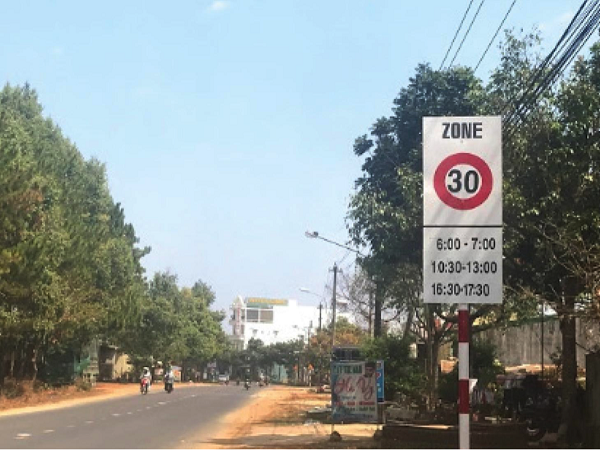 30km/h speed limit at a school in Vietnam. Image credit: Asia Injury Prevention Foundation
30km/h speed limit at a school in Vietnam. Image credit: Asia Injury Prevention Foundation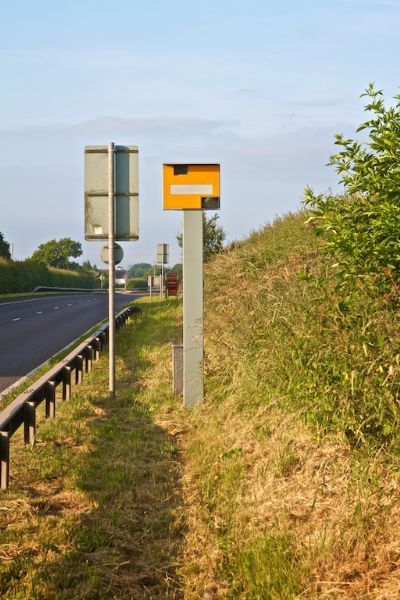 Fixed speed camera on the A34 - UK. Image credit: Unknown
Fixed speed camera on the A34 - UK. Image credit: Unknown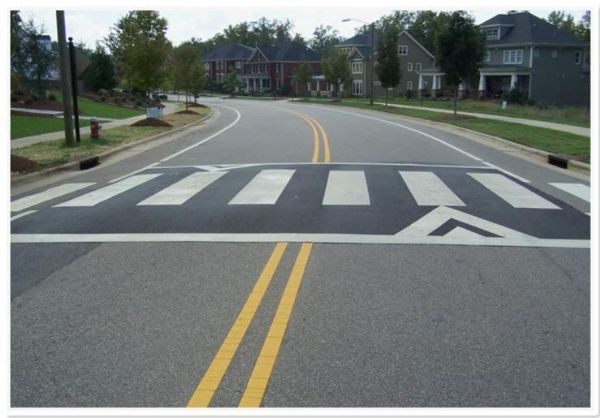 A raised pedestrian crossing facility. Image credit: Unknown
A raised pedestrian crossing facility. Image credit: Unknown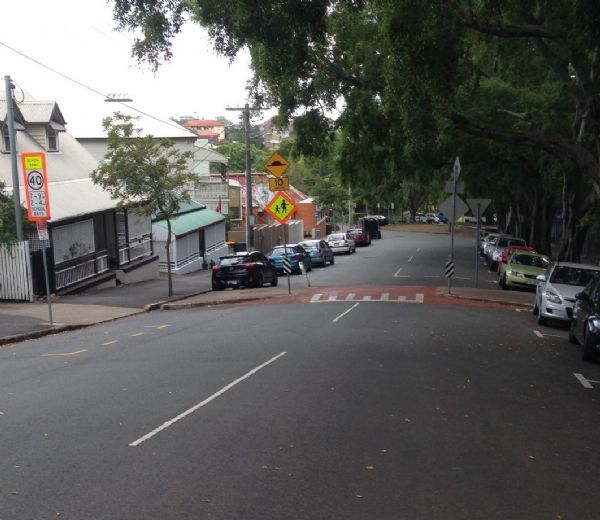 A raised pedestrian crossing with kerb build-out in a school zone in Brisbane, Australia. This is an effective traffic calming measure whilst providing a safe place to cross. Image credit: Luke Rogers
A raised pedestrian crossing with kerb build-out in a school zone in Brisbane, Australia. This is an effective traffic calming measure whilst providing a safe place to cross. Image credit: Luke Rogers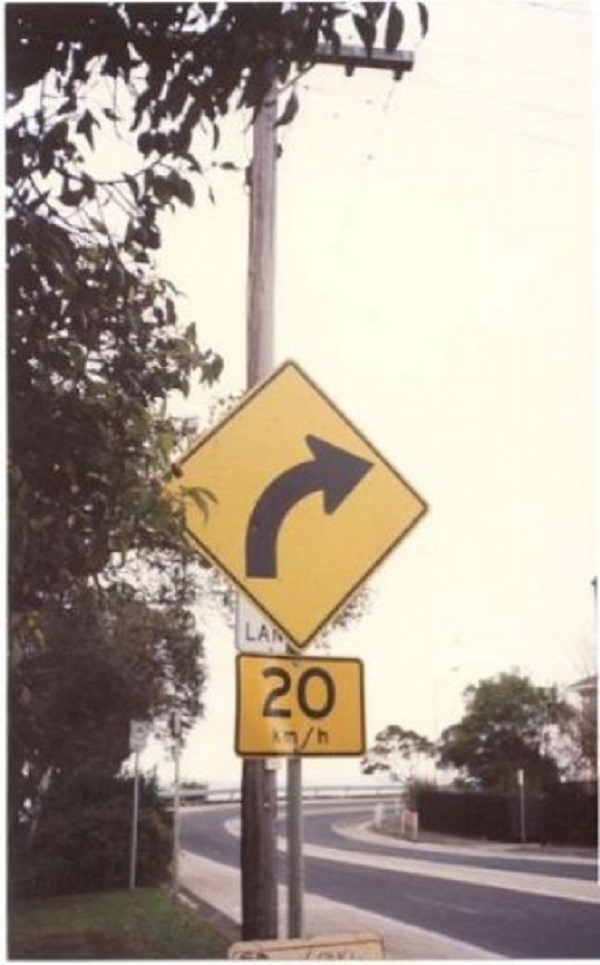 Advisory speed sign plus curve warning. Image credit: ARRB
Advisory speed sign plus curve warning. Image credit: ARRB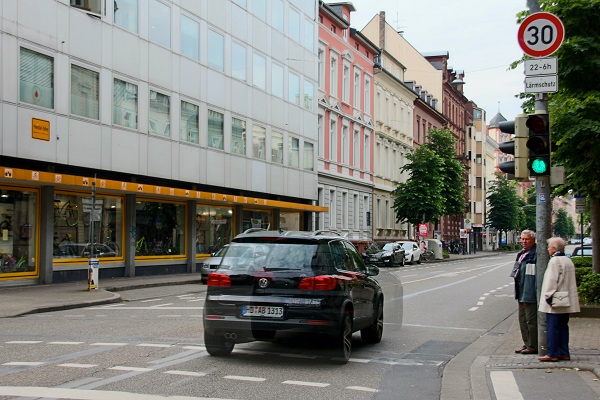 Car passing a 30km/h speed limit sign. Photo credit: RdA Suisse
Car passing a 30km/h speed limit sign. Photo credit: RdA Suisse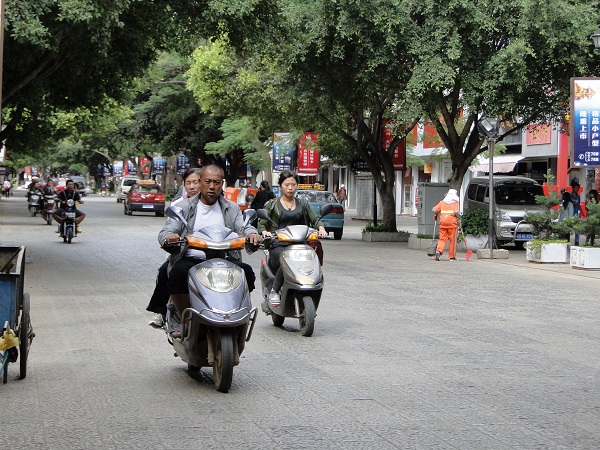 Cobble stone pavement for traffic calming in China. Image credit: Greg Smith
Cobble stone pavement for traffic calming in China. Image credit: Greg Smith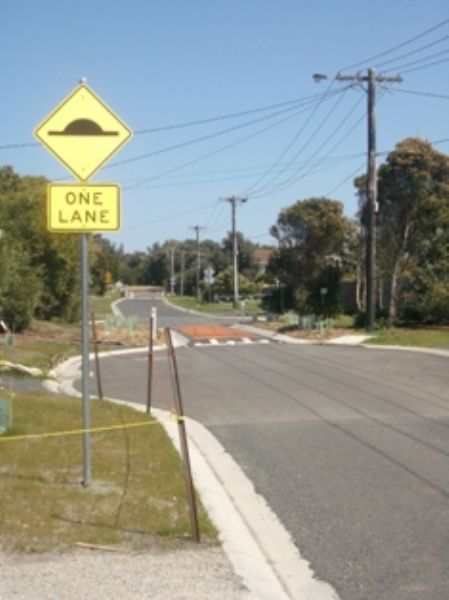 Combination of road narrowing and speed hump on residential street. Image credit: ARRB
Combination of road narrowing and speed hump on residential street. Image credit: ARRB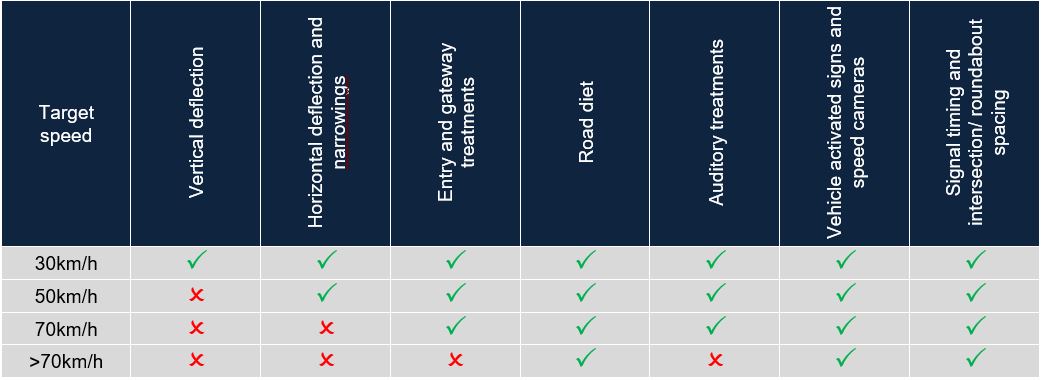 Example list of traffic calming measures, and how appropriate they are for achieving different target speeds. Image credit: iRAP
Example list of traffic calming measures, and how appropriate they are for achieving different target speeds. Image credit: iRAP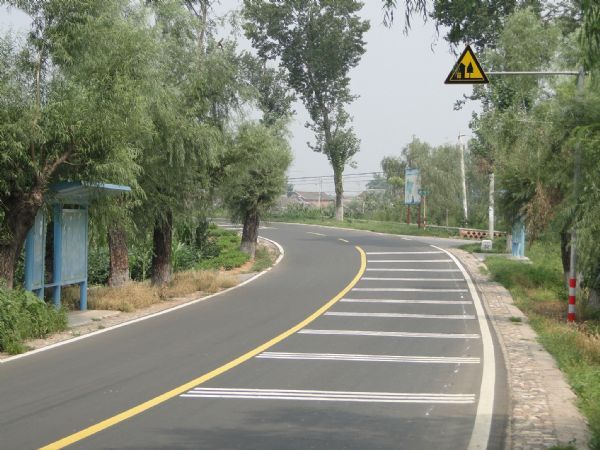 Lateral lines at the entrance to a curve, China. Image credit: iRAP
Lateral lines at the entrance to a curve, China. Image credit: iRAP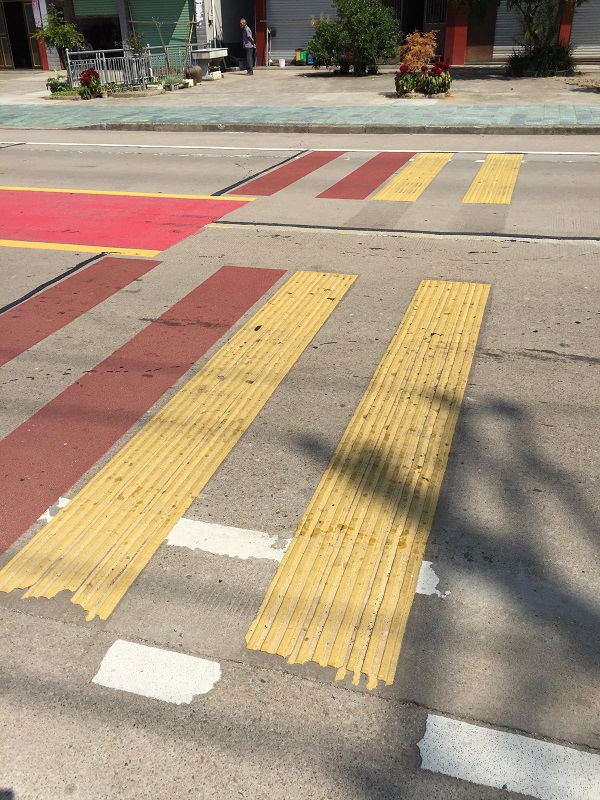 Lateral rumble strips in China. Image credit: Greg Smith
Lateral rumble strips in China. Image credit: Greg Smith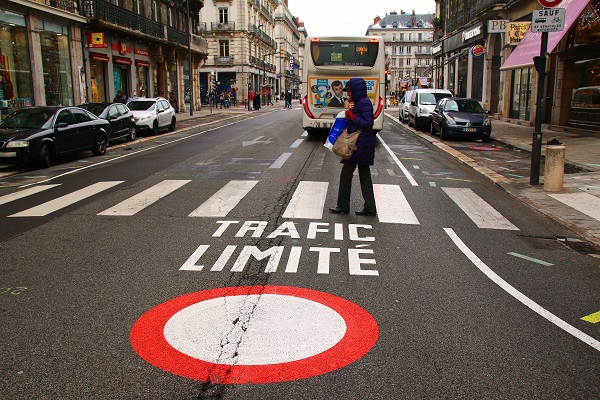 Marked pedestrian crossing facility (Zebra marking). Image credit: Alain Rouiller
Marked pedestrian crossing facility (Zebra marking). Image credit: Alain Rouiller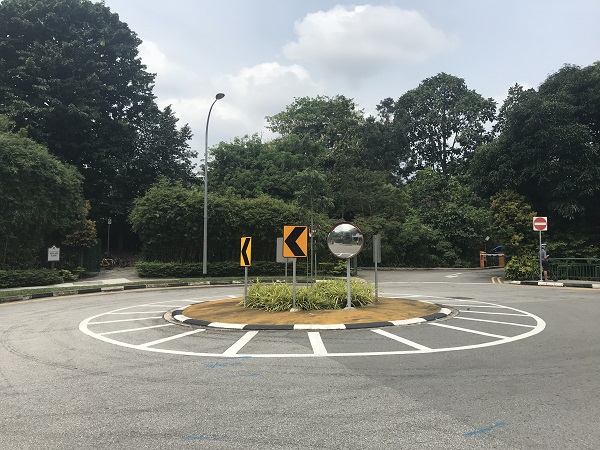 Mini roundabout in Singapore. Image credit: Alina Burlacu
Mini roundabout in Singapore. Image credit: Alina Burlacu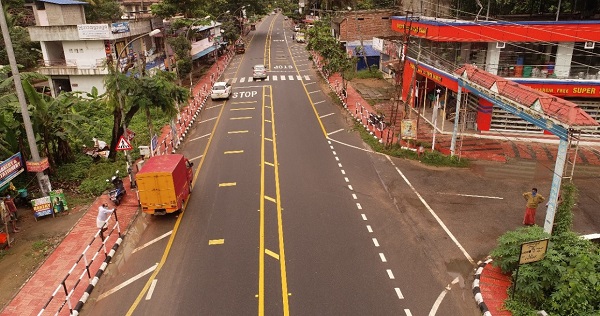 Pedestrian crossing facility with footpath, wide centreline and speed transverse markings to calm speed on a state highway in Kerala, India. Image credit: Kerala State Transport Project
Pedestrian crossing facility with footpath, wide centreline and speed transverse markings to calm speed on a state highway in Kerala, India. Image credit: Kerala State Transport Project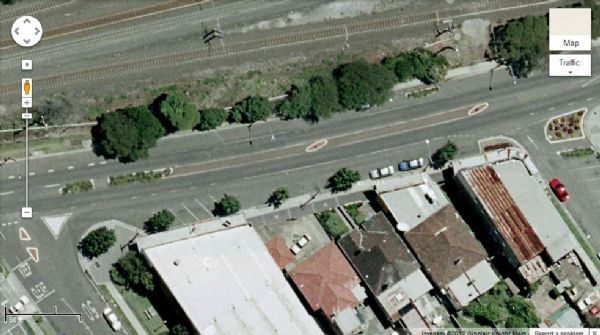 Pedestrian refuges, bicycle lanes, delineation and one-way road treatment. Image credit: Google Maps
Pedestrian refuges, bicycle lanes, delineation and one-way road treatment. Image credit: Google Maps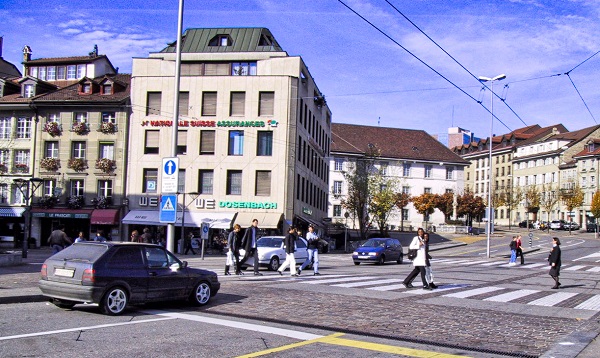 Raised (table-top type) pedestrian crossing facility. Image credit: Alain Rouiller
Raised (table-top type) pedestrian crossing facility. Image credit: Alain Rouiller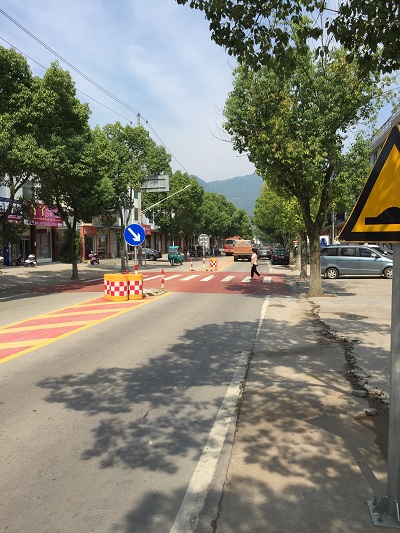 Raised pedestrian crossing in China. Image credit: Greg Smith
Raised pedestrian crossing in China. Image credit: Greg Smith School crossing safety improvements in India. Image credit: TRAX
School crossing safety improvements in India. Image credit: TRAX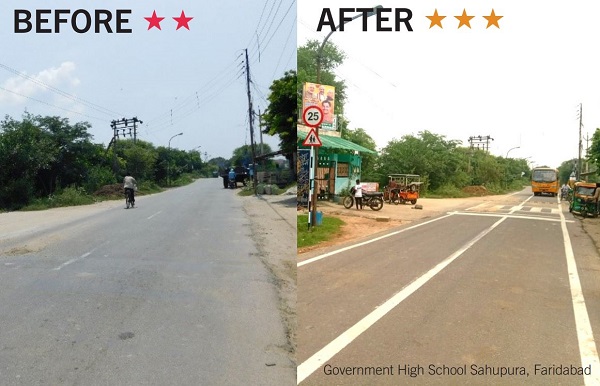 School crossing safety improvements in India. Image credit: TRAX
School crossing safety improvements in India. Image credit: TRAX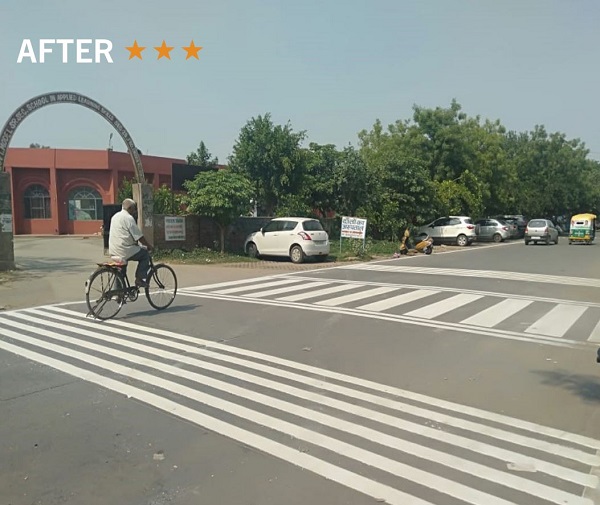 School crossing safety improvements in India. Image credit: TRAX
School crossing safety improvements in India. Image credit: TRAX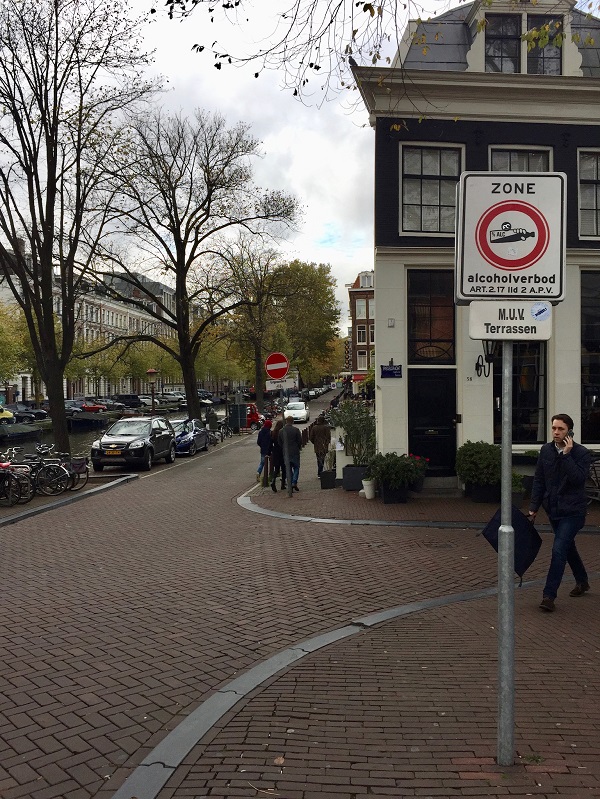 Shared street in Amsterdam, Netherlands. Image Credit: Monica Olyslagers
Shared street in Amsterdam, Netherlands. Image Credit: Monica Olyslagers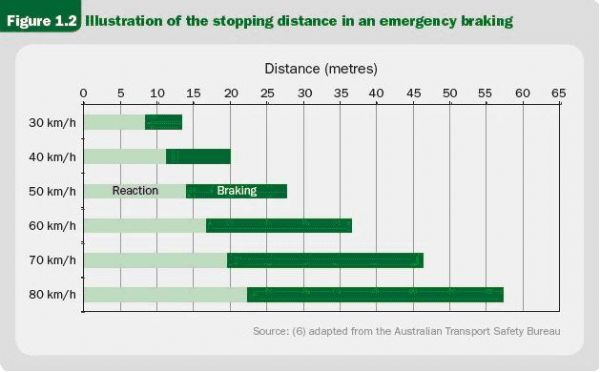 Stopping distances in an emergency. Image Credit: WHO
Stopping distances in an emergency. Image Credit: WHO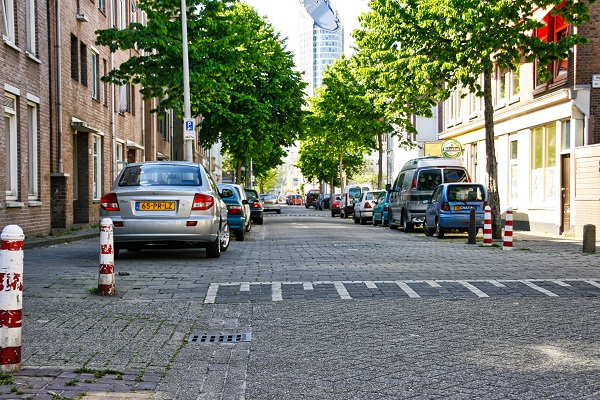 Speed calming by providing raised rough surface paver blocks. Image credit: Monica Olyslagers
Speed calming by providing raised rough surface paver blocks. Image credit: Monica Olyslagers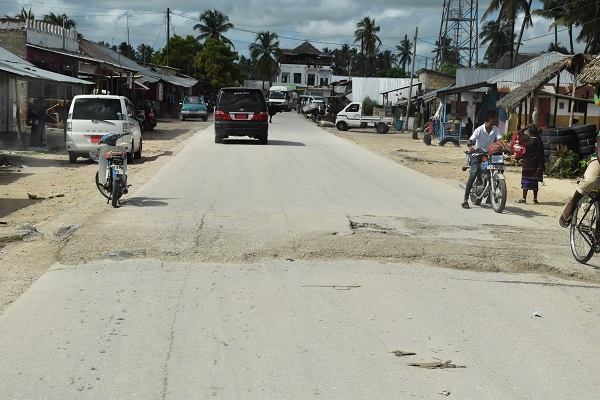 Simple speed hump without delineation in Tanzania. This type of non-standard speed humps pose the risk of causing rear end collisions. Image credit: Alina Burlacu
Simple speed hump without delineation in Tanzania. This type of non-standard speed humps pose the risk of causing rear end collisions. Image credit: Alina Burlacu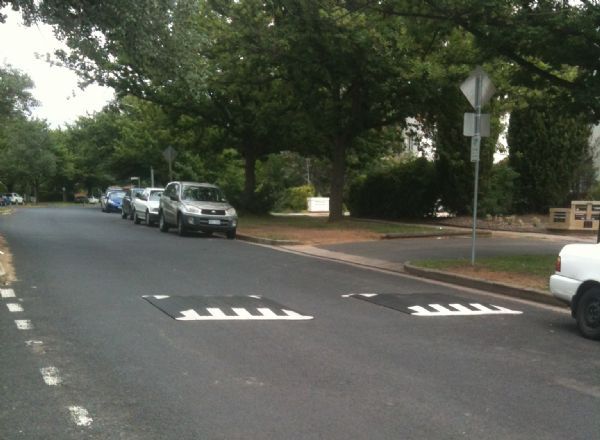 Speed cushions located before a roundabout. Image credit: Jason Smith
Speed cushions located before a roundabout. Image credit: Jason Smith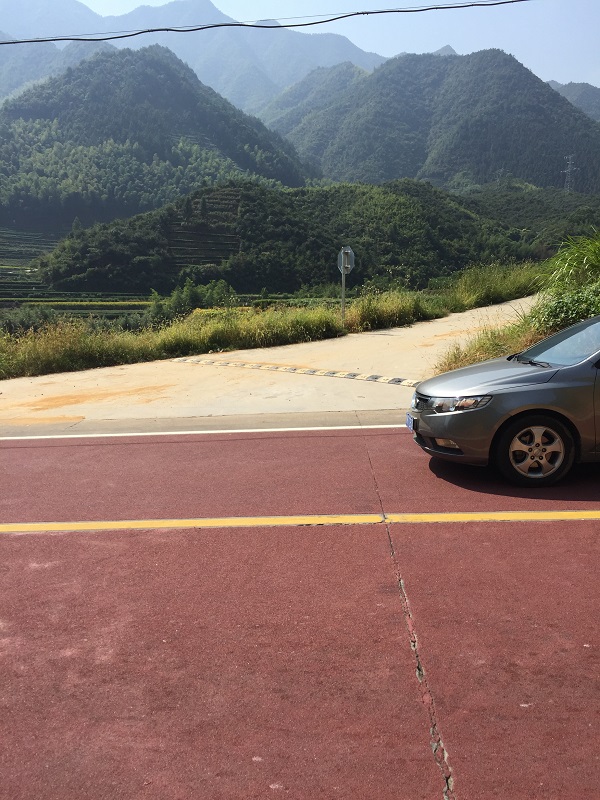 Speed hump on side road and skid resistant pavement treatment in China. Image credit: Greg Smith
Speed hump on side road and skid resistant pavement treatment in China. Image credit: Greg Smith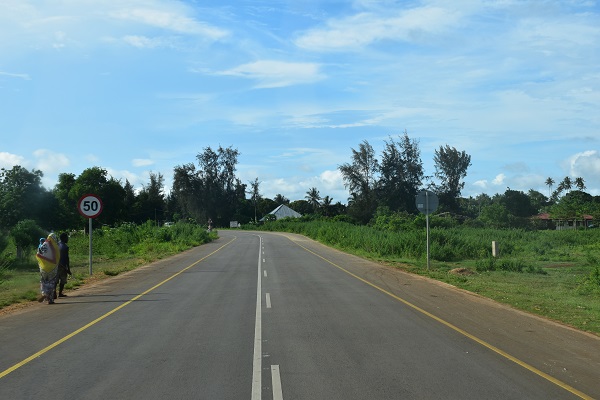 Speed limit sign in Tanzania. Image credit: Alina Burlacu
Speed limit sign in Tanzania. Image credit: Alina Burlacu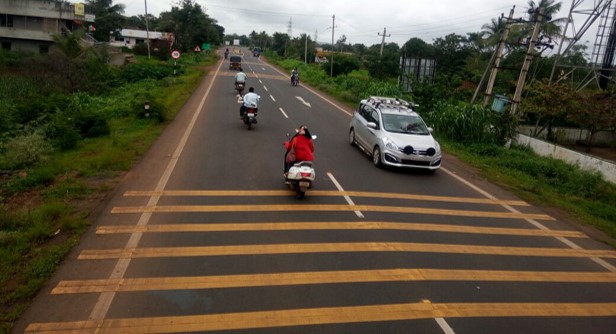 Traffic calming in India. Image credit: World Bank
Traffic calming in India. Image credit: World Bank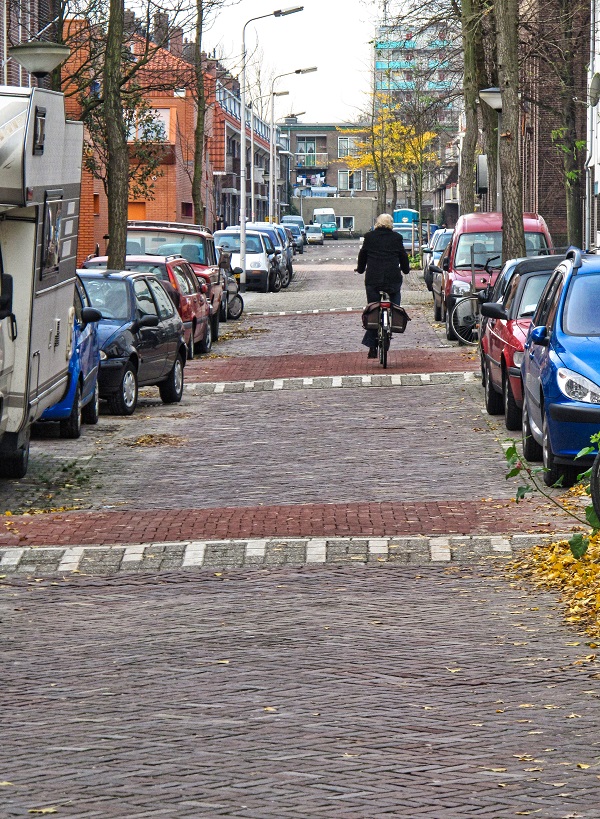 Traffic calming example. Photo credit: RdA Suisse
Traffic calming example. Photo credit: RdA Suisse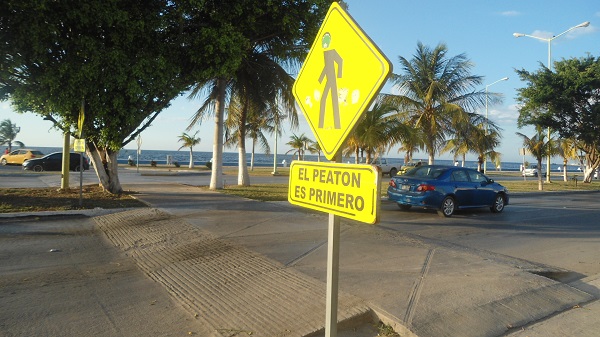 Unmarked raised pedestrian crossing in Mexico. Image credit: iRAP
Unmarked raised pedestrian crossing in Mexico. Image credit: iRAP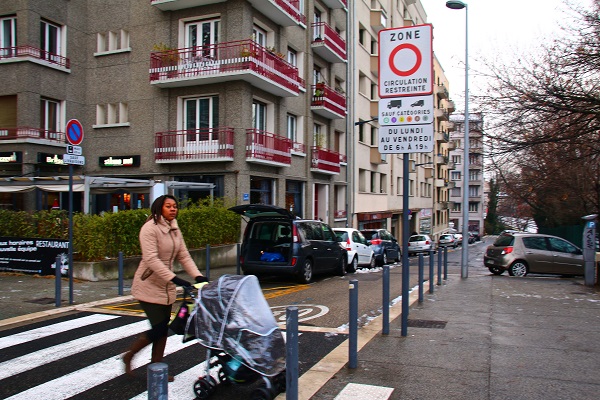 A mother crossing the road with a stroller. Photo credit: RdA Suisse
A mother crossing the road with a stroller. Photo credit: RdA Suisse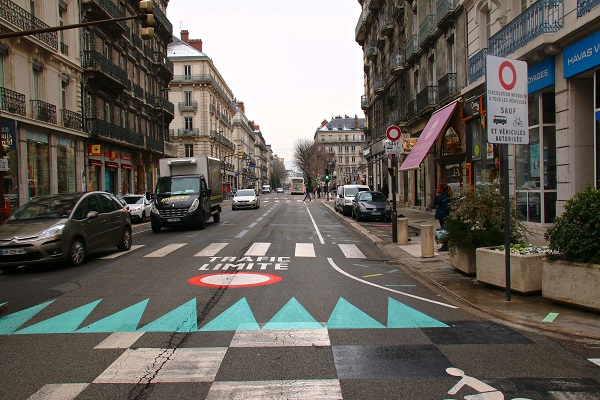 A slow speed pedestrian crossing. Photo credit: RdA Suisse.
A slow speed pedestrian crossing. Photo credit: RdA Suisse.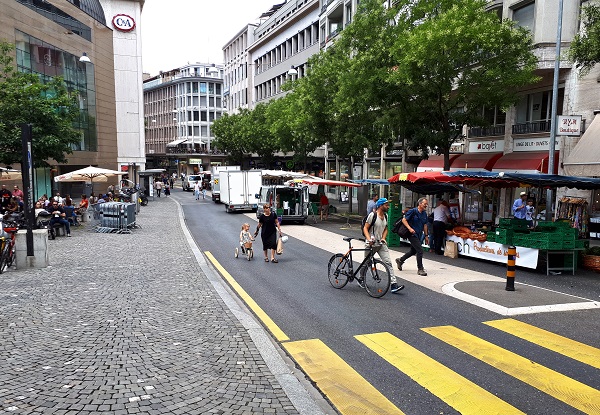 Pedestrians crossing a slow speed road. Photo credit: RdA Suisse
Pedestrians crossing a slow speed road. Photo credit: RdA Suisse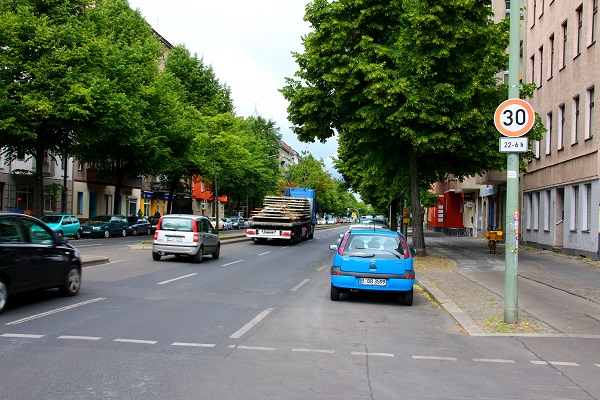 30km/h speed limit. Photo credit: RdA Suisse
30km/h speed limit. Photo credit: RdA Suisse Traffic calming in a local street. Photo credit: RdA Suisse
Traffic calming in a local street. Photo credit: RdA Suisse Village gateway treatment incorporating 30mph speed limit and road narrowing in the United Kingdom. Image credit: Unknown
Village gateway treatment incorporating 30mph speed limit and road narrowing in the United Kingdom. Image credit: Unknown









